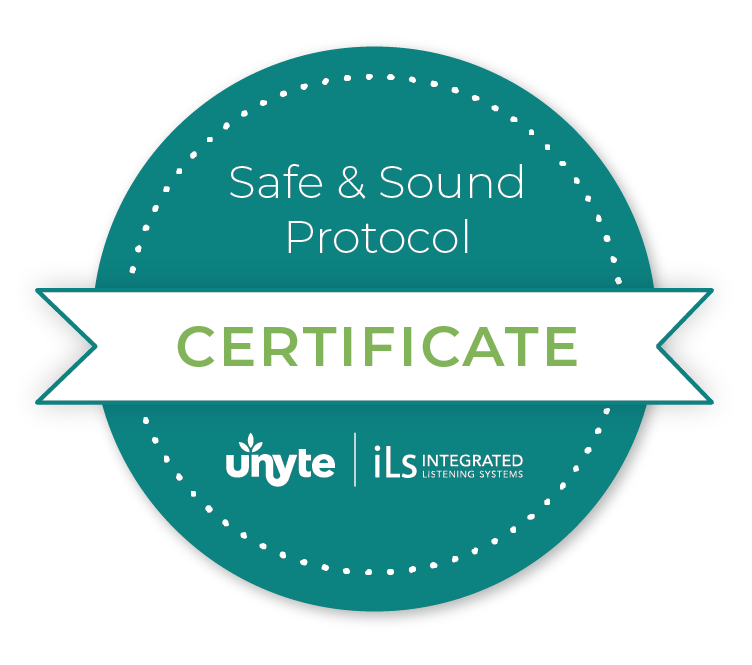
This past year I personally underwent the Safe & Sound Protocol (SSP). I was so impressed by its delivery and results that I went on to become trained and certified to administer it. I am very pleased to add SSP to the work I can offer you in person and/or remotely.
The SSP is a powerful, evidence-based auditory intervention designed to reduce stress and auditory sensitivity, calm behavioral and physiological states, while enhancing resilience and social connection. The SSP is a practical, bottom-up application of Polyvagal Theory.
What, specifically, is the SSP’s auditory intervention?
Music! Basically, it’s music you listen to through headphones.

The music in the Core SSP has been filtered to stimulate and tone the middle ear muscles, which are directly related to the functioning of the vagal nerve. (Middle ear muscles have been found to be un- or under-developed in many people who experience stress or trauma, and/or who have trouble regulating their behavioral state and social engagement.)

The Core SSP intervention consists of five total hours of listening. (Listening time–segments and frequency–will be determined based the individualized plan Heidi makes with you after your SSP intake.)
What kind of things can SSP help?
- Anxiety and trauma-related challenges
- Chronic pain and fatigue
- Depression
- Difficulty sleeping
- Social and emotional difficulties
- Inattention
- Reactivity
- Difficulties in regulating physiological and emotional state
- Auditory processing difficulties
- Auditory and other sensory sensitivities
- Stressors that impact social engagement
- Difficulties with social communication
- Gut issues
Who doesn’t or hasn’t struggled with at least one or several of the things on that list? I know I have. I wonder which ones feel relevant to you…
SSP with Heidi
My facilitation of your SSP can happen on its own, or in combination with therapeutic massage. (After your intake session, an individualized plan is made with Heidi to best address your nervous system and situation.)
SSP may be administered remotely (via Zoom).
While I am not a psychotherapist, SSP is a very good adjunct to psychotherapy, of which I am a huge fan. (How nice would it be to be able to show up for your therapy sessions in a calm state, ready to do the deep work of therapy, rather than spending most of your hour trying to calm down from your most recent upset?)
Curious about SSP for you?
If you’d like to discuss your nervous system and whether SSP is for you, please take me up on my invitation to schedule a 30-minute Complimentary Consult, by putting yourself in my calendar at a time that works for you.
Your consult–think of it as a nervous system meet-n-greet–will take place remotely, via Zoom.
Book My Consult!A few words on the science behind SSP
SSP was developed by and is based in the scientific research of Dr. Stephen Porges on what he has called Polyvagal Theory (PVT). There are many peer-reviewed articles on PVT in scientific journals, but let put it into my own words:
Rather than the “you are broken” or “what’s wrong with you?!” approach to the challenges many of us face on the mental health-illness spectrum, PVT says that when we feel safe, curiosity, connection and playfulness are available to us, and our bodies can rest and digest as needed.
When we don’t feel safe it’s a different story, a story of stress-based defensiveness, a story in which our autonomic nervous system (ANS) may make us fight or run away (sympathetic activation), or shut-down, freeze, or “play dead” (dorsal vagal activation).
All of those reactions are adaptive. They developed to help us stay safe and alive. And, lest we take ourselves and our reactions too terribly personally, we share the having of those nervous system pathways with other creatures in the animal kingdom. The pathways are neurally wired. And ancient.
But because our reactions are wired, they can be “re-wired.” Re-wired so that curiosity is available to us as a response in situations that previously made us, say, yell at someone.
Re-wired so that rest is possible when previously our thoughts wouldn’t stop churning out scary conclusions…in the middle of the night.
Re-wired so that we feel safe in the company of another. Re-wired so that you are on friendly (or at least curious!) terms with that amazing creatures that is YOU.
You get the idea.
Think of SSP as a re-wiring that allows you to respond–when appropriate–from a regulated nervous system, rather than reacting in familiar ways which ultimately don’t help you anymore.
A more scientific explanation of “re-wiring” is that just as the brain is plastic and can change based on experience, the ANS is also plastic. The SSP has been shown to “significantly increase vagal regulation of the heart,” and this in turn results in better control of the state of our ANS.
Why does that matter? It matters because our “state” is critical to how we approach the things we do in our day-to-day lives. When our state is more regulated, we are more available and able to engage and connect in ways that matter to us. Not only that, but therapeutic outcomes of other modalities (like psychotherapy, to name just one) are also improved.
Ready to book your free SSP consult with Heidi?
Book your “Complimentary Consult” by putting yourself in my calendar at a time that works for you.
Consults take place remotely via Zoom. (Remember: available times are listed in Eastern US time zone. I’m happy to work with you anywhere in the world–via internet–but I need to leave the time zone mathematics to you.)
You might like to watch/read:
A YouTube clip of Dr. Stephen Porges on Polyvagal Theory and SSP
Another interview of Dr. Stephen Porges on Polyvagal Theory
Deb Dana’s Rhythm of Regulation Resource page